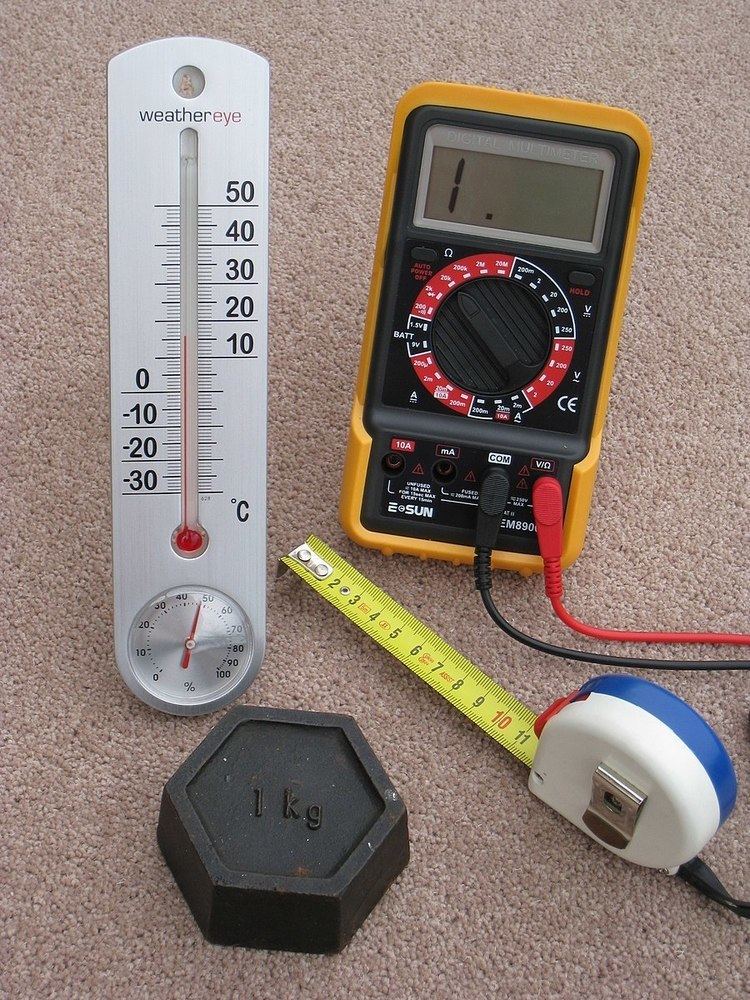The following outline is provided as an overview of and topical guide to the metric system:
Metric system – various loosely related systems of measurement that trace their origin to the decimal system of measurement introduced in France during the French Revolution.
The metric system can be described as all of the following:
System – set of interacting or interdependent components forming an integrated whole.System of measurement – set of units which can be used to specify anything which can be measured. Historically, systems of measurement were initially defined and regulated to support trade and internal commerce. Units were arbitrarily defined by fiat (see statutory law) by the ruling entities and were not necessarily well inter-related or self-consistent. When later analyzed and scientifically, some quantities were designated as fundamental units, meaning all other needed units of measure could be derived from them.Introduction to the metric systemInternational system of units (SI) is the system of units that has been officially endorsed under the Metre Convention since 1960. Child articles are:SI base unitsSI derived unitNon-SI units mentioned in the SISI prefixesDiscussions of the underlying philosophy of the metric system (and other systems of measure) include:
Coherence (units of measurement)Realisation (metrology)Articles that exist for many units of measure that are related to various flavours of the metric system are catalogued below. The codes in the various columns have the following meanings:
A - Base unitB - Multiple or submultiple of a base unitC - Derived metric unit with a special nameD - Derived coherent metric unit that has no special nameE - Non-coherent unit explicitly permitted for use within the metric system (SI only)F - Unit of measure that has an association with the metric systemX - No specified relationship (Other metric only)History of the metric system – the metric system developed from a decimal system of measurement adopted by France after the French Revolution.
Principal dates in the development of the metric system include:
1792 - Initiation of a decimal system of measurement by the French Revolutionary Government1799 - The Metre des archives and kilogram des archives become the standards for the metric system.1861 - Concept of unit coherence introduced by Maxwell - the base units were the centimetre, gram and second.1875 - Under the Convention of the metre, a new body the General Conference on Weights and Measures (CGPM) was set up and given responsibility for the new international prototype kilogram and international prototype metre which replaced the old French copies as the definitive prototype metre and kilogram.1881 - International Electric Congress agrees on standards for electrical units (formalised in 1893)1921 - Convention of the metre extended to cover all physical units of measure1960 - The CGPM published the metric system under the name "International System of Units" (SI) a coherent system of units based on the kilogram, metre, second, ampere and kelvin.History of metrication – metrication is the process by which legacy, national-specific systems of measurement were replaced by the metric system.
Metrication in AustraliaMetrication in BarbadosMetrication in CanadaMetrication in ChileMetrication in GuatemalaMetrication in Hong KongMetrication in IndiaMetrication in IrelandMetrication in JamaicaMetrication in New ZealandMetrication in PeruMetrication in SwedenMetrication in the United KingdomMetrication of British TransportBritish Metrication BoardMetrication in the United StatesPlan for Establishing Uniformity in the USA, Thomas Jefferson's report (1790) which included a proposal for decimal system based on a "decimal foot"United States Metric BoardFour variants of the metric system that predate the introduction of SI (1960) are described in varying levels of detail:
MKS system of units formed the basis for SI.Centimetre–gram–second system of units was the principal variant of the metric system that evolved in stages until it was superseded by SI.Gravitational metric system was a little-used variant of the metric system that normalised the acceleration due to gravity.Metre–tonne–second system of units was a variant of the metric system used in French and Russian industry between the First and Second World Wars.Between 1812 and 1839 France used a quasi-metric system:
Mesures usuellesHistory of the metrePrior to 1875 the metric system was controlled by the French Government. In that year, seventeen nations signed the Metre Convention and the management and administration of the system passed into international control.
Metre Convention describes the 1875 treaty and its development to the modern day. Three organisations, the CGPM, CIPM and BIPM were set up under the convention.General Conference on Weights and Measures (Conférence générale des poids et mesures or CGPM) – a meeting every four to six years of delegates from all member states.The International Committee for Weights and Measures (Comité international des poids et mesures or CIPM) – an advisory body to the CGPM consisting of prominent metrologists.The International Bureau of Weights and Measures (Bureau international des poids et mesures or BIPM) – an organisation based at Sèvres, France that has custody of the International Prototype Kilogram, provides metrology services for the GCPM and CIPM, houses the secretariat for these organisations and hosts their formal meetings.Both the European Union and the International Organization for Standardization have issued directives/recommendations to harmonise the use of units of measure. These documents endorse the use of SI for most purposes.
European units of measurement directivesISO/IEC 80000New SI definitions – changes in the metric system, or more specifically, the International system of units that is expected to occur in 2018.U.S. Metric AssociationMetric CommissionMetrication BoardAn Essay towards a Real Character and a Philosophical Language Reproduction – 34.7 MB, Transcript 127 kB (John Wilkins 1670)Plan for Establishing Uniformity in the Coinage, Weights, and Measures of the United States text (Thomas Jefferson 1790)Simon Stevin (1548-1620)John Wilkins (1614-1772)Gabriel Mouton (1618-1694)Marquis de Condorcet (1743-1794)Pierre Méchain (1744-1804)Pierre-Simon Laplace (1749-1827)Jean Baptiste Joseph Delambre (1749-1822)Adrien-Marie Legendre (1753-1834)James Clerk Maxwell (1831-1879)William Thomson, 1st Baron Kelvin (1824-1907)Giovanni Giorgi (1871-1950)
